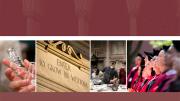 |
| "Your wooden arm you hold outstretched to shake with passers-by." |
The first installation of a Harvard president about which we know details--told by historian of Harvard Samuel Eliot Morison '08, Ph.D. '12, Litt.D. '36, in Harvard College in the Seventeenth Century and Three Centuries of Harvard--is that of the great John Leverett, A.B. 1680, which occurred on Wednesday, January 14, 1708.
The occasion dismayed former president Increase Mather, A.B. 1656, and son Cotton, A.B. 1678, and their kind, who wished Harvard to be kept "the divinity school of a particular sect" (their own), because Leverett was a layman and a liberal, chosen for an office, wrote Morison, "always filled by an orthodox puritan parson." He was "liberal in his attitude toward religion, conservative in politics, and withal a man with an innate sense of government, a majestic manner of speech, and a deportment that 'struck Awe upon the Youth.'" Cotton Mather called him, posthumously, an "infamous drone," but Morison judges that he "founded the liberal tradition of Harvard University."
The inauguration took place in Old Harvard Hall. Governor Joseph Dudley, A.B. 1665, took Leverett by the hand, it is written, and led him into the hall, where Fellows, Overseers, scholars, and "a numerous Company of Gentlemen from severall Parts" were assembled. The Reverend Nehemiah Hobart, A.B. 1667, said a prayer. Judge Samuel Sewall, A.B. 1661, gave an oration in Latin. Governor Dudley, in the same tongue, delivered to the president the keys of the College, the seal, and the charter as emblems of office. (The same charter and seal were presented to Lawrence H. Summers, Ph.D. '82, on October 12, 2001; see page 112.) Leverett responded, and Edward Holyoke, A.B. 1705, who would one day be president himself, orated, both of them in Latin; the Reverend Samuel Danforth, A.B. 1683, prayed; and the entire company sang a psalm.
Feasting ensued. "The Steward's accounts," Morison writes, "show what victuals and drink were consumed by the Corporation and their fifty-odd guests on that festive occasion: 146 pounds of beef, pork, and mutton; 14 fowls, 4 turkeys, 19 apple and mince pies, and 16 gallons of wine; 4 dozen church-warden pipes and two pounds of tobacco were provided to top off the repast. Judge Sewall concluded his account of the ceremony, 'Got home very well. Laus Deo.'"

Designated Harvard undergraduates were among the numerous delegates from universities, colleges, and learned societies processing into Tercentenary Theatre to sit upon the platform for President Summers's installation. This provision was wise as well as seemly, for at the installation of President Jared Sparks, A.B. 1815, in 1849, students had limited access to events and rioted in their disgruntlement. Newspapers reported that in his effort to quell the disturbances, Abraham Edwards, marshal of Cambridge, allegedly seized one of the students, a weakly one, and threw him over the College fence. Edwards was thereafter handled rather roughly by experts in boxing at the College, and 25 students were hauled in.
The mayhem may have been the high point of the day. One newspaper reported that the formal exercises were marked by "much inexcusable sluggishness and delay in the movement of officials." Another account held that the "speeches were horribly long, without possessing any extraordinary compensating merits," and were heard by a "heated and panting congregation." The singing of the undergraduates was "excruciating and should never be repeated."

A chorus of 160 alumni serenaded Abbott Lawrence Lowell, A.B. 1877, LL.B. 1880, on October 7, 1909, at the first--and grandest--installation of the twentieth century, a two-day blowout recounted vividly by John T. Bethell '54 in his book Harvard Observed. The Boston Symphony Orchestra gave a concert in Sanders Theatre on the evening of day one. Students then marched from the Yard to the Stadium, "each carrying a torch and wearing a red sash. The Stadium's colonnade was festooned with red Japanese lanterns; one set of goal posts was hung with lanterns forming a fiery red H. The undergraduates marched twice around the track and assembled to cheer the new president, who responded with a brief speech. The evening was climaxed by fireworks and a blazing set piece in the open end of the Stadium that spelled out Lowell, Harvard."
~Primus V





